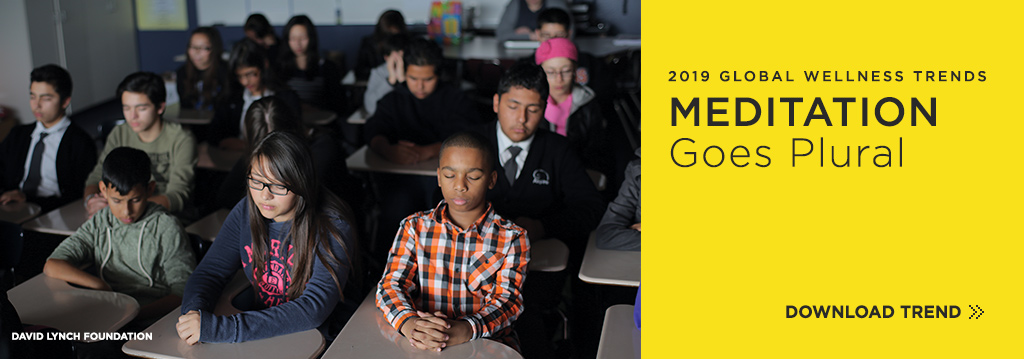Meditation Goes Plural
No more singular, generic “meditation.” People will get clearer about the core meditation types and their unique brain impacts—just as this explosive market will bloom into many varieties.
By Beth McGroarty
It’s hardly breaking news that meditation is one of the most powerful wellness trends. In a few short years, it has been installed—along with a healthy diet and exercise—as one of the three pillars of wellbeing. With promising early evidence that it’s a uniquely powerful solution for our stressed-out, digitally addicted, distracted times, we’ve all seen the magazine covers announcing that a “Mindful Revolution” has arrived and how meditation is the anxiety-attacking and focus-restoring choice of everyone from Silicon Valley entrepreneurs to government leaders. And if it feels like nothing has ever been talked about so much, now people are actually doing it. According to the CDC, for example, meditation is now the fastest-growing health trend in America, with the number of meditators tripling between 2012-2017. Meditation studios, brands and apps are spawning worldwide—with Apple naming mental wellness/mindfulness apps the #1 app trend of 2018. It can sometimes feel as if we’ve reached maximum, peak mindfulness and meditation…
…But we haven’t because the growth in people practicing is matched by profound confusion around the very concepts. For something that delivers clarity, there’s serious confusion around how the terms “meditation,” “mindfulness” and “mindful” are used, which infects many of the medical studies. One crucial problem is that the terms meditation and mindfulness get used generically and interchangeably, when there are general agreement and scientific research to support that there are really three core types (as we shall see below) that involve different practices, which translates into different impacts on the brain, and different benefits (outcomes): 1) focused attention 2) open monitoring (which includes mindfulness meditation) and 3) self-transcending meditation. In the recent meditation boom, it’s the different breeds of mindfulness meditation (paying attention in the present moment without judgment) that have become dominant, and it’s led to a conflation of all meditation with mindfulness. And if mindfulness meditation is a real practice (a noun), through the marketing of “mindful everything,” it has become a fuzzy adjective and lifestyle trend applied everywhere—whether “mindful eating,” “mindful parenting” or “mindful boxing.” What’s next? Mindful waterboarding?
And this mixing up of all meditation types has infected—and hence devalued—too much of the clinical research. There are now hundreds of randomized and neuroimaging studies on meditation approaches, but too many are plagued by inconsistent definitions and a muddied methodology about what they’re exactly studying, whether a focused attention or self-transcending meditation type. This is what happens: in meta-analyses, researchers average the results of disparate meditation studies’ impact on X to tally up results and then make pronouncements, such as “meditation is positive for pain” or “meditation shows little impact on anxiety.” With such generalizations, you’re already in Dangerville. What kind of meditation—at what dose? And these methodological problems in studies are leading to a serious backlash, with recent headlines such as, “Our Obsession with Mindfulness Is Based on Limited Scientific Evidence,” and where groups of top scientists argue that “for all the excitement about mindfulness meditation in contemporary culture, evidence of its benefits is limited.” Note how even in the critiques of the muddied studies, mindfulness meditation stands in for all meditation!
Meditation is at an adoption and conceptual tipping-point. Even though types have been practiced in Buddhist, Hindu and Jewish traditions for over 5,000 years, as a modern endeavor, it’s very young. The future: Meditation will move from a singular to a plural practice—from a generic concept to specific types, with people starting to understand their specific brain mechanisms and outcomes. More research will study (to start, at least) the three main types head-to-head and with more solid randomized controlled trials when types are studied individually.
This is crucial because the hot market of meditation will “go plural” in a whole other way. If people used to take a “meditation” class or do “meditation” at a wellness retreat, now new ancient and modern breeds will multiply—with very different practices from Kundalini yoga to sophrology trending in 2019. More apps and meditation studios will become one-stop shops for diverse meditation types, with sometimes jaw-droppingly full menus. The wave of new brain and meditation technology will keep rising, such as the Muse headband that uses biofeedback to customize meditation practices or more wellness destinations experimenting with mild-brain-zapping transcranial direct current stimulation (tDCS) to make meditation easier and deeper.
At the 2018 Global Wellness Summit, new approaches in mental wellness were a big topic, with the Global Wellness Institute’s Mental Wellness Initiative’s in-depth report, “Mental Wellness: Pathways, Evidence and Horizons” released, analyzing the dizzying array of evidence-based mental wellbeing practices now available. As the report’s editor Professor Gerry Bodeker (University of Oxford, Columbia University) notes, “Meditation is mainstreaming now, and it’s just in time to counteract the epidemic of stress that threatens our society.”
And it was Bob Roth’s talk (CEO of the nonprofit David Lynch Foundation and one of the world’s top experts on meditation) that inspired and set the entire direction for this trend. Roth has taught Transcendental Meditation (TM) for 50 years to thousands of people: from at-risk youth and veterans with PTSD to celebs such as Oprah Winfrey, Hugh Jackman, Katy Perry, Jerry Seinfeld and George Stephanopoulos. And at the David Lynch Foundation he has overseen bringing TM for free to over one million inner-city kids in 35 countries. Roth argues that we need to adopt the framework of the three core meditation types (which may be familiar to research insiders but are not to most regular people) and consider how the dozens of meditation varietals fit into the three core types.
And it’s Roth that predicts—in 2019 and beyond—that meditation will move from singular and generic to plural and specific. As he notes, “The current science and understanding of meditation is at a very early stage. Imagine if we categorically stated, ‘medicine affects health,’ or ‘diets affect weight loss.’ It’s not very helpful information. The future is more medical studies evaluating the types head-to-head and more people grasping that specific meditation practices have specific benefits for specific people. It’s not that one is better than the other, per se. And it shouldn’t be an either/or but really a yes/and—because we should think of meditation types as a personal toolbox. Definitions will get sorted out, the research will focus on specific types and outcomes, and it’s only this that will take meditation from hyped fad to an evidence-based medical intervention.”

FUELING THE TREND
Rising stress and depression
Rates of anxiety and depression are galloping around the world; one could cite hundreds of studies. Globally, one in six people now has at least one mental or substance abuse disorder (over 1.1 billion people)—with anxiety disorder ranking #1. In the UK, 67 percent of people report that they’re more stressed than they were five years ago; in the US, major depression is up 33 percent since 2013 (and up 47 percent for millennials); In China, 40 percent of adults report they experience a lot of stress daily. While studies on different types of meditation’s impact on stress and mood need to test types head-to-head, the research on various meditation types’ impact on stress and mood is too promising, and the world is desperate for low-cost solutions with no side effects. So many early studies suggest this: from those indicating that meditation produced changes in brain circuits involved in regulating emotion to those showing that mindfulness meditation reduced stress markers, such as cortisol. The cost of all this stress—as it’s the seed of so many diseases from high blood pressure to Alzheimer’s—is simply unsustainable. And calming our “gotta, gotta, gotta” minds will not only drive growth in all “meditations,” it will drive the study of which ones work best for individuals.
Meditation: Where Yoga Was Two Decades Ago—Mainstreaming & Evolving
Just a few years ago, meditation was a fringe activity for insider wellness types, but it’s now clocking the meteoric growth yoga did 20 years ago. While there’s no global data on meditation adoption and market size, you can look at the US market as one snapshot: Pew Research reports that 40 percent of Americans say they meditate at least weekly, and the CDC reports meditation is now tied with yoga as the top two alternative medical practices in the US. It’s all about exploding access: more meditation at fitness studios and more dedicated meditation centers, more meditation at work and in schools—and, of course, via meditation apps, which are pulling in hundreds of millions in investment and reaching hundreds of millions of people. It’s a market growing exponentially, set to double, for example, in the US, from $1.2 billion in 2017 to $2 billion by 2022.[1] And the growth is all part of a skyrocketing, larger “anxiety economy”—that’s risen because of things such as the smartphone, the 24-hour bad news cycle, social media and climate change stress. Like all markets, whether fitness or yoga, industry growth leads to diversification (new brands and new models). Think of the head-spinning number of yoga and boutique fitness brands/concepts that now exist. That same evolutionary force will now take the meditation market “plural.”
Aspects of the Trend
Understanding the 3 core types of meditation & their brain impact becomes more important
Roth argues that to ground our understanding of meditation and its effects, we should first embrace a three-type meditation classification paradigm: 1) focused attention 2) open monitoring and 3) self-transcending. While there are hundreds, if not thousands, of meditation practices and brands, the three categories analyzed below represent the generally agreed-upon and best-studied mechanisms that are operating across the increasingly crowded meditation landscape. All are legitimate techniques involving different practices and outcomes. (And all have benefits—you wouldn’t want to choose between Vitamins A, C or D). Most meditations will activate more than one of those mechanisms or exist on a continuum between open monitoring and focused attention.
More head-to-head studies on these core types are starting to clarify how they impact the brain and the benefits they have. A 2017 Max Planck Institute study (cited below) studying brain MRIs compared focused attention and open monitoring meditation against each other, finding that these types of meditation are associated with changes in different brain regions. An earlier study was the first to analyze the impact of the three meditation types on electrical brain waves, whose frequencies correlate with a different state of consciousness (more below).
There are five brain waves, each with a distinct purpose—from fastest to slowest they are Gamma, Beta, Alpha, Theta and Delta.
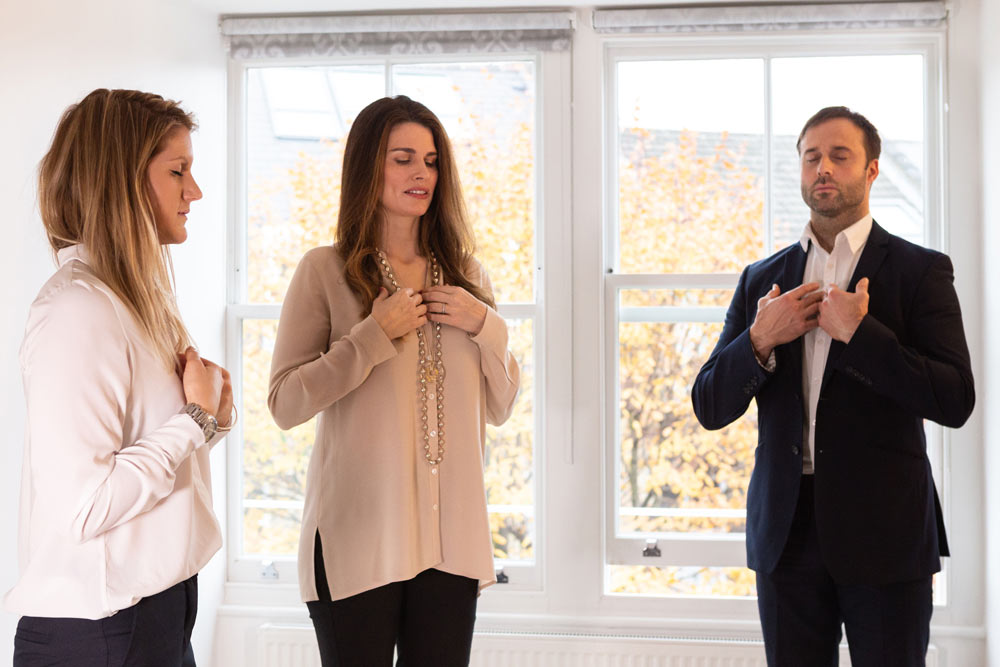
Focused Attention Meditation
This type of meditation involves training to clear the mind of thoughts through concerted concentration exercises, such as focusing on objects, the breath or bodily sensations. And the mind is brought back to that object of focus when it wanders. As Roth notes, in this form of meditation, thoughts themselves are often seen as the disrupter, even the obstacle to mental calm, focus and higher awareness. Vipassana meditation, believed to come from Buddha himself, as well as other meditations from the Tibetan Buddhist and Chinese traditions, are part of the focused attention category.
Brain impact: Because the meditator is intensely controlling his or her own attention, research[2] shows that the practice creates very fast Gamma brain waves at 20–50 cycles/second (also with some Beta activity), which are involved in higher processing tasks and cognitive functioning, such as learning, memory, and the binding of our senses in regard to perception. Research also shows that focused attention meditation leads to a higher volume of gray matter in prefrontal brain regions, which are all about attention, higher-level awareness and monitoring. Other research has suggested that this form of meditation reduces depression and anxiety and improves sleep.
Roth summarized, “It can be a particularly powerful tool to train the mind to focus more intently and to be less scattered in your thinking.”
Open Monitoring Meditation (Includes Mindfulness Meditation)
The most practiced breed in the West (as it includes mindfulness meditation), open monitoring meditation, as Roth puts it, does not see thoughts as the disruptor of our calm but rather it is often the content of our thoughts. It involves training in how to pay attention in the present moment and, as (negative, stressful) emotions and thoughts and physical sensations come up, learning to observe them in a dispassionate, nonjudgmental way. So, it’s not about stopping thinking or emptying the mind, but rather learning how to dispassionately observe the mind’s “content.” You often begin open monitoring meditation with a body scan (where you move through the body slowly, paying attention to each part and sensation) or by focusing on your breath and then expand to opening up awareness to thoughts, sounds and feelings that arise.
It spans many familiar kinds of meditation, such as Mindfulness-Based Stress Reduction (MBSR), created by Jon Kabat-Zinn in 1979, an eight-week course offered in clinics and hospitals around the world that uses both the body scan and breath awareness. (Kabat-Zinn was a powerful force in bringing mindfulness meditation to the West.) Or Loving Kindness Meditation, which often uses repetition of phrases to extend kindness and love out from the self to loved ones and the rest of the world. It includes chanting meditations or sound meditations/baths that use vibrations and sound to drive present-time awareness. And it includes the vast majority of guided meditations served up on the exploding number of meditation apps, such as “meditation for work” or “meditation for grief.”
Brain impact: Research[3] indicates that open monitoring (and mindfulness) meditation primarily generates slow Theta brain waves at 4–8 cycles/second (and secondarily Alpha 2 waves at 10–12 cycles/second). Theta waves are dominant in daydreaming and sleep and are associated with a relaxed, emotionally open and connected state of mind. There are many studies on open monitoring/mindfulness meditation. A Carnegie Mellon University study showed that an eight-week mindfulness meditation course shrunk the amygdala (the brain’s “fight or flight” center, involved with fear and stress). And as the amygdala shrinks the prefrontal cortex (that region of high-level brain processes, such as awareness, focus and decision-making) becomes thicker—so our primal responses to stress get overtaken by more thoughtful, calm ones. As Zev Schuman-Olivier, director of the Center for Mindfulness and Compassion at Cambridge Health Alliance (associated with Harvard Medical School) summarized, “What we see with mindfulness meditation is this improvement in attention and cognitive control…and in emotional regulation again and again.”
Self-Transcending Meditation
This type of meditation is strikingly different than focused attention or open monitoring/mindfulness in that it’s not concerned with regulating thoughts or feelings and involves no mental effort—so it’s very easy to learn and do. If focused attention and open monitoring meditation involves using cognitive processes to change cognitive processes (thoughts to change thoughts), self-transcending meditation does not. Using the analogy of the ocean, which can be turbulent at the surface but quiet at its depth, Roth says the mind is the same: naturally active on the surface and quiet at its depth. TM utilizes a mantra (a sound that has no meaning) to effortlessly “dive within” to access the field of silence that lies deep within the mind. Unlike other forms of meditation that are often taught in large groups – or through an app, book or tape – TM is taught in personal instruction from a certified instructor who has completed a six-month training program. Other modern examples of self-transcending meditation include the practices served up at ZivaMeditation.com or Deepak Chopra’s Primordial Sound Meditation, which forges your mantra from a particular vibrational sound prevalent at the place/time of your birth.
Brain impact: Research[3] shows that self-transcending meditation increases Alpha 1 brain waves at 8–10 cycles/second, which are associated with quiet, flowing thoughts, such as daydreaming, and with states of relaxed alertness (it’s the resting state for the brain). TM has been widely studied, with more than 400 peer-reviewed studies conducted since 1970. And the research shows everything from how it calms the amygdala reactivity center and strengthens connections within the prefrontal cortex, which is also called the executive center or CEO of the brain. Numerous studies have also documented its benefits to heart health, including a 2013 report from the American Heart Association that found TM to be as effective as medication in reducing blood pressure for patients with high blood pressure. A US Department of Defense-funded study found TM to be more effective in reducing PTSD symptoms in veterans than prolonged exposure therapy.
Roth also notes that TM awakens the brain’s default mode network, also known as the “imagination network,” where creative, innovative thoughts arise. On the other hand, research shows that the more effortful techniques of Focused Attention and Open Monitoring actually suppress the imagination network. It may be why TM is so popular with creative types.

Action on the Meditation Front for 2019
Meditation will continue to blow up in 2019, taught at more schools and workplaces (meditation rooms are the hot, new perk)—and found everywhere from airports to museums to your Peloton bike. More ancient and new breeds will take off as people become more comfortable with the practice and want to explore further—and realize multiple meditations have multiple benefits. The landscape will get more confusing. (Yes, there’s now baby goat meditation, what could be more distracting?) Some practices that call themselves “meditation” will not be a real meditation practice but will rather reach for a mindful or meditative state (our old noun-adjective problem). What’s fundamentally an ancient practice will increasingly be delivered by slick apps. And a whole new slate of “meditation technologies” will track our meditating brains and interact with us to deepen the experience.
A few meditation trends to watch…
Sophrology
One unique thing about the wellness world is the constant importing and exporting of established practices, and out of Europe now comes sophrology—or “dynamic meditation.” Sophrology is an emerging stress-management technique that marries components from Eastern meditation practices and Western relaxation concepts—and it’s gaining serious interest worldwide. The practice was created by Spanish neuropsychiatrist Alfonso Caycedo in the 1960s as a structured method for conquering anxiety and building consciousness, and it’s a technique (there are 12 levels of study) that combines components of mindful meditation (Tibetan Buddhist and Japanese Zen); breathwork; guided visualization; phenomenology; and gentle, mindful movement, such as yoga.
It’s been popular across Europe for decades (where there are thousands of practitioners): used in the medical world, in schools to help students manage stress, to help women prepare for birth, in the corporate world to prevent burnout, and with sports stars to get in the right mind for big events. In places such as France and Switzerland, it’s routinely covered by health insurance. And now this 50-years-young practice is gaining traction in the UK, Asia and the US. It’s particularly on the rise in the UK, with the shining example being the three BeSophro clinics in London, run by Dominique Antiglio, author of the best seller The Life-Changing Power of Sophrology. And now, there’s a new Online from BeSophro platform launching so the rest of the world can train. You can now practice sophrology at a wellness resort, such as Spain’s SHA Wellness Clinic; at numerous studios in Hong Kong, such as the Integrated Medicine Institute; via many French apps, such as Sophrologie Avec Petit BamBou; or at the American Sophrology center in Scottsdale, Arizona. (It’s just picking up in the US, but celeb fans include Arianna Huffington.)
Practitioners agree that it’s a powerful way to reach calm and self-awareness for those who may struggle with meditation. No complex thinking or postures required, it only involves 20–30 minutes a day, and, because it has 50 years of solid use in Europe and its roots are medical, it may appeal to skeptics or those put off by the spiritual vibe of some meditation classes.
Kundalini yoga
Of all the breeds of yoga, the most meditation-heavy, Kundalini yoga, has got to be the hottest right now. And moving from sophrology to it, we’re definitely moving from the secular to the spiritual. It has an air of mystery about it, as ancient Hindu Kundalini yoga teachings were kept secret (and reserved for nobility) for thousands of years until Yogi Bhajan brought it to the West, you guessed it, in the 60s. It’s a millennia-old mash-up of most of the yoga tools, both spiritual and physical, and incorporates chanted mantra, dynamic breathing techniques, movement and asanas, and many mindfulness-based meditations. (Each sequence is called a kriya and has a sequence of these components, with classes ending with a meditation.) Practitioners wear all flowing white, the teacher wears a turban, and with gong baths and group chanting, walking into a class feels like witnessing the uber-trend of once New Age practices going mainstream before your very eyes. Kate Hudson and Alicia Keys are just two of the celeb devotees.
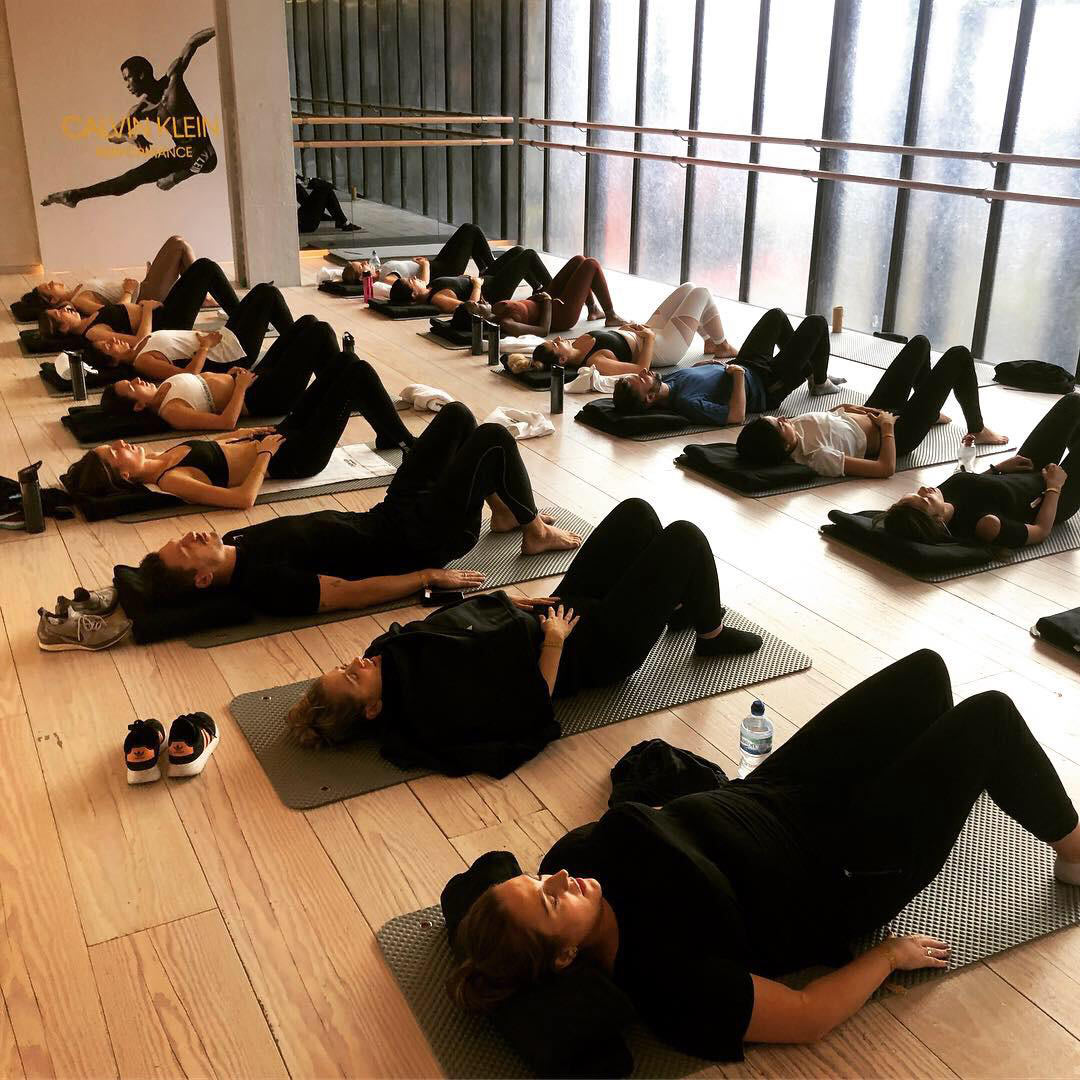
It may also be trending because it meets people’s new desire for a personalized plurality of meditations, as the founder Bhajan passed on thousands of very specific meditations designed for specific goals: whether to boost beauty or energy or to fight stress and addictions. The practice is very prescriptive: you perform meditations for a specific challenge a certain number of times with precise gestures.
People credit Guru Jagat, a young American practitioner, with bringing Kundalini yoga to the millennial generation and making it very cool. Her RA MA TV, dubbed the “Netflix of Kundalini yoga,” broadcasts her virtual classes to thousands of subscribers in 180 countries. More Kundalini yoga classes are now popping up in cities everywhere—from Singapore (Kundalini Yoga with Akashakyi) to Santa Monica (Kundalini Yoga by the Sea).
Mindful fitness surges
One of the most powerful wellness trends is adding mindfulness to the workout, either in fitness classes where you’re trained to move consciously with intention and/or by ending classes with a dose of mindful meditation (this trend’s practices fit into the open monitoring category). That long-lived hyphen between “mind-body” is being strengthened and literally addressed in this trend, and the new mindful fitness speaks to people wanting solutions that meld physical and mental wellness in one class or platform. You can see fitness expanding to mental wellness everywhere, such as in Peloton’s recent foray into meditation (and yoga), and they’re now serving up on-demand meditation sessions, such as breath-focused and guided visualization classes.
Being mindful while moving has ancient precedents: Walking meditation has long been a Buddhist practice where one focuses on the breath or on the body’s movement through space.
And now there is a rush of mindfulness-meets-fitness moves globally. Pioneering fitness chain Equinox (US and UK) integrates mindfulness meditation practices into classes, with a fitness class called HeadStrong revolving around mindfulness. Running shoe company Asics just created “the world’s first running track to train your mind” (called the Blackout Track), which removes light and all distractions to create a “meditative running environment.” SHA Wellness Clinic in Spain has a new weeklong fitness program that intersperses physical workouts, such as boxing and hiking, with stress-reducing practices, such as meditation and sophrology, to work both the body and mind in equal parts. The NYC fitness program Body Activation, created by a professional dancer, blends the hot trend of stretching with the open monitoring-based body scan, progressing from the feet to the head—and ends the physical training with meditation.
Combining mindfulness training with fitness obviously seems best suited for exercise that’s more “mindless,” such as cardio and running, because with sports that require intense concentration (such as boxing or football), you would run the concentration needed for mindful meditation right up against the intense focus needed to execute the moves—diminishing, rather than adding to, both. There isn’t much clinical evidence yet around the mindful fitness concept, but an interesting study from Rutgers University found that MAP (Mental and Physical) Training (combining aerobic exercise with silent mindfulness meditation) led to some eye-opening results, including significant neurogenesis and a greatly boosted ability to concentrate—while 40 percent of participants in the “combo” clinical intervention found a permanent solution to their depression issues.

More mindful spa experiences
More spas are creating mindfulness and treatment mash-ups. Some might begin with a guided mindfulness meditation session, then move on to treatments, and finish with a guided visualization—like those at Mexico’s Nizuc Resorts & Spa. Things are getting pretty creative. At the Shore Club Turks and Caicos, they offer an out-in-nature Twilight Ceremony (held at twilight), which combines mindful meditation with massage, sage burning and prayers.
The Mindfulness Spa Experience at Santuario LeDomaine spa (at Abadia Retuerta LeDomaine) in Spain, uses virtual reality technology to deliver guided meditations—a pretreatment ritual that focuses the guest’s mind on the treatment to come while guiding their breathing—to make the touch experience and stress-reduction deeper. One of the hottest treatments in L.A. is Jeannette von Johnsbach’s BioMeditation sessions at the Four Seasons Hotel Los Angeles at Beverly Hills, a long, hands-on therapy that combines meditation to incite a dream-like state with touch and energy healing to clear energy blockages.
“Shaking meditation” is shaking
A practice called Tension and Trauma Release Exercise (TRE) —that’s being called “shaking meditation”—is on the rise. And while it’s not a meditation practice per se, its effects could be called meditative. It involves a series of controlled exercises that take you to that place where your muscles start to tremble, to unlock the body’s tension and trauma of getting stuck in protective patterns (tense muscles, clenched jaws, shallow breathing, etc.). The goal is to reduce stress, shut down the fight-or-flight instinct, and rest your mind. (Yes, you will be shaking on the floor.)
Classes are being offered at more yoga and wellness studios. It’s big in the UK, with at least 100 TRE providers, and it’s where TRE guru Steve Haines teaches at the chic Triyoga studios in London. Learning how to shake off your trauma has been taught everywhere from Sacred Space in Miami, to the new TRE for Life studio in Uganda. There’s also a phone app (Stress Less TRE), and soon there will be a UK TRE Association, where trainers will share their tips and expertise.
More drop-in meditation studios—with deep, diverse menus
As much as we hate the phrase “X is the new Y,” the boom in drop-in meditation studios worldwide indicates that meditation is very much the new yoga. There are so many examples, including pioneers such as NYC’s MNDFL (now with three locations) and L.A.’s The DEN Meditation (now with two). So many more cool, around-the-corner meditation places are opening all the time, such as Inhere meditation studio in London (founded by a neuroscientist); Re:Mind in London; Meditation Bar in Austin, Texas; Enhale in Hong Kong; and MINDSET Brain Gym in Toronto (where they use brain wave-sensing tech to chart your progress). In New York, you don’t even need to “drop in” to do your mindfulness meditation because the Be Time meditation studio on wheels drops right in on you.
What’s so striking when you peruse these studios’ all-day programming is just how many types of meditation are on offer. And it’s nice to see a studio, such as NYC’s suave INSCAPE, offer guided meditations that follow the logic of the core types based on evidence for brain changes: mindfulness meditation, focused attention, mantra-based meditation, etc.
Another major trend in the wellness world is new wellness center and club concepts that put incredibly comprehensive wellness offerings (doctors, coaches, yoga, meditation, fitness, stress-reduction treatments, healthy nutrition, etc.) all under one roof—such as the new THE WELL in Manhattan. And these new wellness clubs and studios are rolling out extraordinary and “plural” meditation menus. HealHaus, the new, headline-grabbing wellness studio in Brooklyn (which is all about healing mental wellness approaches that recognize that life can sometimes be pretty tough) features an amazing lineup of meditation classes—with (as we count) 14 different meditation classes every day, from transcendence meditation to loving kindness meditation to mindful breath meditation—and that doesn’t even include their workshop menu. (They plan to open in cities such as L.A., Washington D.C. and Atlanta.)
When Six Senses opens its first urban wellness resort in NYC in 2019, it will feature the ahead-of-the-curve Six Senses Place, a wellness club open to both hotel guests and local members. It’s hard to even wrap your mind around all their planned wellness programming (for a wellness lover, it will be like being in a healthy candy store). And their menu around meditation and other neuroplasticity-driving brain boosters will be wildly creative: from multiple meditation and mindfulness classes to breathwork to chanting to conscious movement to meditative visual healing to nootropics to binaural beats to neurofeedback to expertly delivered Transcranial Direct Current Stimulation (tDCS), where low levels of neurostimulation are targeted at different areas of the brain and used to drive meditative brain states (more below). As more people get used to these rich meditation menus, the idea of the old “meditation class” will feel almost quaint.
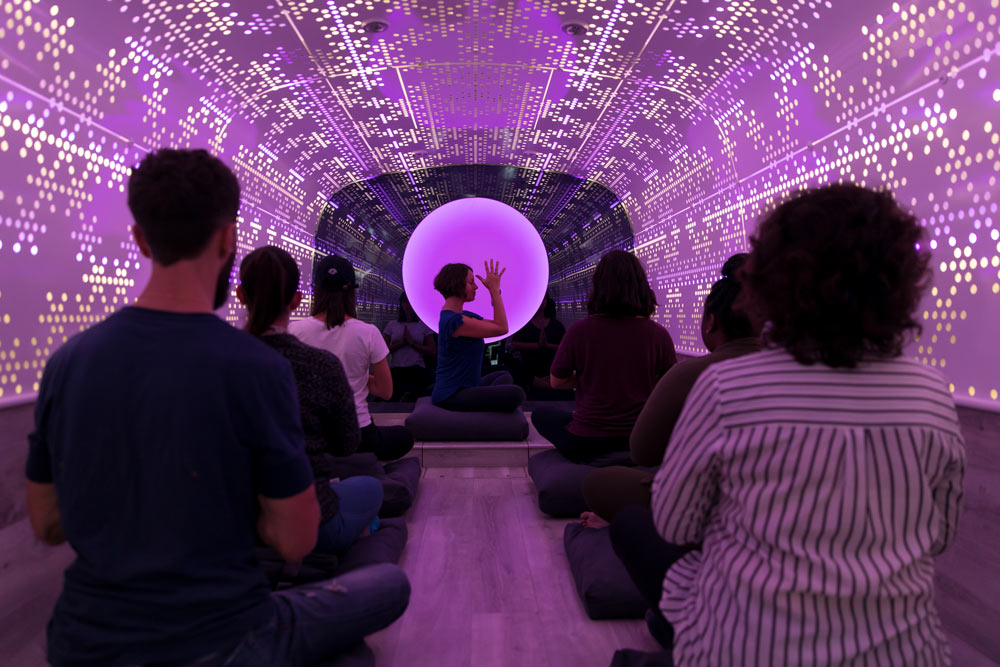
Apps bring meditation to the masses—and get people used to flipping meditation “channels”
There are now, according to estimates, roughly 1,500 meditation and mindfulness apps—and there’s no doubt that there has been no greater force ever in making the idea of meditation less mysterious and more accessible. Headspace alone has 35 million users in 190 countries while Calm has driven 26 million downloads with 50,000 new signups each day. While it’s important to note that the vast majority of meditations they serve up are the mindfulness meditation variety, they all have a different angle and vibe.
Headspace, Calm and MindFi, like so many of these apps, target their content and meditations toward specific life issues, such as mindful exercises for managing anger, falling asleep, or dealing with a bad relationship. Buddhify is based on what you’re doing right now, such as walking, trying to sleep, or scrolling through Instagram, and then serves up a meditation or insight based on that activity. The new Insight Timer is very different: It’s a sort of clearinghouse for 2,000 guided meditations from a network of 1,500 real teachers (most unaffiliated with the app) with the stated goal of “giving meditation away for free to everyone on the planet.” The INSCAPE app aims to be the “Spotify of mindfulness,” and it’s encouraging that they stress known, active-mechanism techniques: focused-based, mindfulness, visualization and mantra-based, meditations.
Now that most meditation practice has been app-ified, there are things to ponder. It’s indisputable that they’re bringing meditation to millions of more people. However, they’re also creating platforms that create an expectation of endless “meditations,” the kind of programming we are used to from Netflix. People need to understand that a good deal of what these apps serve up is not a “meditation practice.” There is often much wellness advice and wisdom and inspirational positive psychology (which is great), but at those app-moments, one is not practicing meditation. It’s too tiresome to ponder the irony that it is apps that will help us disconnect from the stresses of technology. But there are things to mull: We passively consume so much screen-based media, and now meditation is part of that. Is there a difference in the outcome from taking that meditation class in person (showing up and doing the work) compared with a guided meditation via an app? Scientists don’t know, and they should study it. By app-ifying all kinds of wellness, are we bypassing perhaps the most important thing that the wellness world delivers—community with other humans, group rituals, healthy things that happen with real teachers and people?
New technologies aim to boost and personalize—as well as hack—the meditation experience
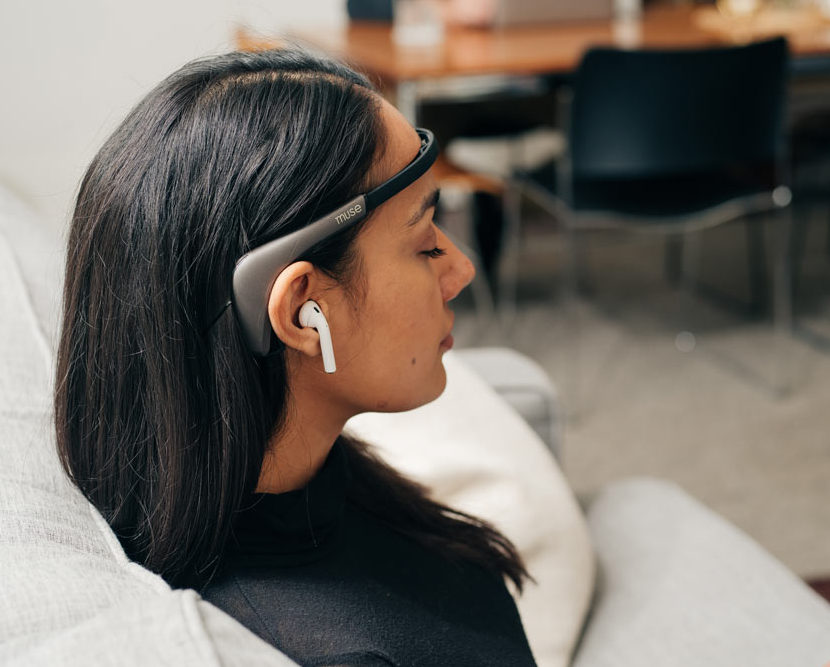
A new flurry of technology solutions, using things such as biofeedback, EEG (brain wave) tracking, tDCS, and other biometric measurements, are aiming to boost and deepen meditation practices and to optimize and personalize the experience in real time. Another trend is tech that hacks the brain to produce meditation states without the need to meditate. Who would have ever thought that there would be a rising, distinct “meditation technology” space?
The new Muse 2 “brain sensing” headband is a standout. Its sensors track EEG brain signals, heartbeat, breath and body movements to deliver a meditation experience that changes and gives audio feedback in real time to guide you into a calm, focused state. For instance, your busy mind will create a rainstorm, your calmer mind a light drizzle, and if your brain waves are truly quiet, you hear birds chirping. Muse’s goal is to take the guesswork out of meditation. And it gamifies the experience (you get rewarded for meditation achievements) while it also sends that breathing and heart rate data back to your phone to keep you engaged with your progress. The DreamOn wearable uses low-frequency pulses to lull your brain to sleep, but is also designed to be used as a meditation aid (and can walk you through meditations and breathing techniques). The Umay REST’s Thermal Meditation device was engineered to counteract the toll taken on our eyes and brains from being glued to digital devices 10 hours a day: It sits on your eyes, and its thermal therapy is aimed at restoring eye health while its “Thermal Meditation” (gentle vibration patterns for guided breath meditation) is designed to calm and clear the mind.
Healium is a virtual-reality-based meditation experience that runs on your brain waves and heartbeat to create a personal, interactive meditation environment. Through a wearable connected to the app, your EEG (and other) feedback create your VR meditation world—you may find yourself scaling mountains or relaxing near a waterfall. And a study in Frontiers of Psychology found that it only took four minutes for Healium to reduce anxiety. At L.A.’s Upgrade Labs, which positions itself as the world’s first biohacking health and fitness facility that “uses technology to help members reach their highest level of physical, cognitive and cellular performance,” they offer EEG brain training and treatments, such as Theta Delight, to hack and induce meditative states.
In general, more researchers are exploring how tDCS, where electrodes are placed on your forehead to deliver mild positive and negative shocks to your brain, could help with many neurological or psychological issues—whether depression, insomnia or Parkinson’s disease. And they’re studying how it could make meditation easier and deeper, such as increasing electrical activity in the insula while dialing it down in the default mode network. The thesis: brain stimulation + meditation = much more effective meditation. And we’ll see more devices/headsets deploy transcranial direct current stimulation, like Swedish start-up Flow that connects to an app that supports meditation.
You will see more wellness resorts using EEG technology and transcranial magnetic stimulation to optimize brains, reduce stress, and create blissed out meditative states, such as SHA Wellness Resort’s new “cognitive enhancement therapy” and at Six Senses Place coming to NY this year.
The Future

One of the maddening things about the wellness market is the constant promotion of the next and newest trend, so the most crucial, evidence-driven approaches fall off trends lists and people’s radar (because, like, meditation is “so 2015”). As if there was an annual expiration date on 5,000-year-old solutions. We really need to digest how young the research on and market around meditation is: It only bubbled up in the West 50 years ago and has only started to approach mainstream understanding, interest and investment a few years ago.
For a practice that’s all about finding calm and clarity, the debates around meditation are so unusually heated and contradictory. It seems to hold on its shoulders a lot of stress: It will solve everything or it solves nothing—it’s by nature a critique of ego-driven capitalism or it’s the best way to become a better entrepreneur—it’s become an unspiritual, commercial McMindfulness or it’s by nature too religious. (Christian groups are now suing to keep meditation out of US schools.)
There is much confusion about what meditation is and does. Mindfulness has come to stand in for all meditation types, and there’s been the relentless application of the adjective “mindful” onto things that are not meditation practices. And mostly, there’s been confusion about how different meditation practices impact the brain and what health outcomes result. While most scientists would now agree that different practices show distinct patterns of brain activity and effects, there is much work to be done on systematically comparing different kinds of meditation and how they affect various cognitive and emotional measures.
It’s the usual throw-down to the more resource-challenged wellness world (unlike big pocketed Big Pharma): More, bigger and more rigorous studies are needed. Agreed! The future is more independent research that studies the three main types (to start) head-to-head and with bigger, more rigorous randomized controlled studies for individual meditation types. You can see movement underway. For instance, Brown University just created eight-week training programs to compare focused attention and open monitoring meditations against each other, to give researchers the needed tools to test their mechanisms and clinical outcomes. The David Lynch Foundation is committed to large investments in independent, randomized controlled trials testing self-transcending meditation on its own and head-to-head, with studies from 1,000 to 4,000 subjects. (The DLF is currently funding an independent study on the impact of self-transcending meditation on several thousand NYC public school students—from how it impacts anxiety and depression to academic performance and graduation rates.) And we believe, as governments and medical systems increasingly become bankrupted by stress-related disorders, they will invest more research dollars too. So, it’s not unlikely that in 5–10 years, backed by growing evidence, that doctors will prescribe distinct types of meditation for distinct mental and physical issues.
We’ll all somehow have to get used to saying “meditations.” And we need to start distinguishing between new and different types because, not only is the future for meditation practices bright, that future will be much more “plural”: more choices that are more personalized to what we each need most.
Endnotes
[1] MarketData Enterprises research, 2018
[2] Fred Travis, “Focused Attention, Open Monitoring and Automatic Self-Transcending,” Consciousness and Cognition, vol. 19, issue 4, (December 2010): 1110–1118.
[3] Fred Travis, “Focused Attention, Open Monitoring and Automatic Self-Transcending.”
Copyright © 2018-2019 by Global Wellness Summit.
If you cite ideas and information in this report please credit “2019 Wellness Trends, from the Global Wellness Summit”.
For more information, email beth.mcgroarty@www.globalwellnesssummit.com.
